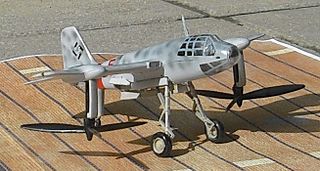History
Hoykenkamp's main claim to fame is to be the place where, starting in 1937, German helicopters were constructed and built by Focke Achgelis. During World War II it became a target of allied air raids and during the nights of June 28 and June 29, 1942 was bombed by British bombers. The construction facilities were subsequently re-built. In 1944 the management of Weser Flugzeugbau GmbH transferred from Berlin to Hoykenkamp, taking over offices from Focke Achgelis.
As part of the Focke Achgelis and Weser Flugzeugbau GmbH wartime activities, a number of specialists but also forced laborers were relocated to Hoykenkamp and barracks were placed on the local sports grounds.
To facilitate access to Hoykenkamp from Bremen, Hoykenkamp got its own railway station on the Bremen to Oldenburg and Bremen to Nordenham lines.
Aktien-Gesellschaft „Weser" was one of the major German shipbuilding companies, located at the Weser River in Bremen. Founded in 1872 it was finally closed in 1983. Altogether, A.G. „Weser" built about 1,400 ships of different types, including many warships. A.G. „Weser" was the leading company in the Deutsche Schiff- und Maschinenbau AG, a cooperation of eight German shipbuilding companies between 1926 and 1945.

Focke-Wulf Flugzeugbau AG was a German manufacturer of civil and military aircraft before and during World War II. Many of the company's successful fighter aircraft designs were slight modifications of the Focke-Wulf Fw 190. It is one of the predecessor companies of today's Airbus.
Henrich Focke was a German aviation pioneer from Bremen and also a co-founder of the Focke-Wulf company. He is best known as the inventor of the Fw 61, the first successful German helicopter.
Vereinigte Flugtechnische Werke (VFW) was a German aerospace manufacturer formed by the 1964 merger of Focke-Wulf and Weser Flugzeugbau GmbH (Weserflug). The formation of VFW was a natural outcome of the 1961 rocket technology development alliance between the two merger partners and Hamburger Flugzeugbau (HFB) in the Entwicklungsring Nord (ERNO) group.
Weser Flugzeugbau GmbH, known as Weserflug, was an aircraft manufacturing company in Germany.
The Entwicklungsring Nord - abbreviated ERNO - was a 1961 joint venture of Bremen-based Weserflug and Focke-Wulf with Hamburger Flugzeugbau to develop parts for rockets and get involved in space activities.

VFW-Fokker GmbH was a joint venture of Fokker and Vereinigte Flugtechnische Werke (VFW) started in 1969 that, from then on, controlled the ERNO initiative.
Bücker-Flugzeugbau GmbH was a German aircraft manufacturer founded in 1932. It was most notable for Its highly regarded sports planes which went on to be used as trainers by the Luftwaffe during World War II.

Delmenhorst is an urban district in Lower Saxony, Germany. It has a population of 74,500 and is located 10 kilometres west of downtown Bremen with which it forms a contiguous urban area, whereas the city of Oldenburg is 25 kilometres to the northwest. The city has a total area of 62.36 square kilometres ; and a population density of approx. 1200 inhabitants per km².

The Jade Bight is a bight or bay on the North Sea coast of Germany. It was formerly known simply as Jade or Jahde. Because of the very low input of freshwater, it is classified as a bay rather than an estuary.

The Focke-Achgelis Fa 223 Drache was a helicopter developed by Germany during World War II. A single 750-kilowatt (1,010 hp) Bramo 323 radial engine powered two three-bladed 11.9-metre (39 ft) rotors mounted on twin booms on either side of the 12.2-metre-long (40 ft) cylindrical fuselage. Although the Fa 223 is noted for being the first helicopter to attain production status, production of the helicopter was hampered by Allied bombing of the factory, and only 20 were built.

Weserstadion is a multi-purpose stadium in Bremen, Germany. The Weserstadion is scenically situated on the north bank of the Weser River and is surrounded by lush green parks. The city center is only about a kilometre away. It is the home stadium of German Bundesliga club Werder Bremen.

Ludwig Roselius was a German coffee merchant and founder of the company Kaffee HAG. He was born in Bremen and is credited with the development of commercial decaffeination of coffee. As a patron, he supported artists like Paula Modersohn-Becker and Bernard Hoetger and turned the Böttcherstrasse street in Bremen into an artwork.

Brake is the district seat of Wesermarsch district in northern Germany.

Deutsche Schiff- und Maschinenbau Aktiengesellschaft was a cooperation of eight German shipyards in the period 1926 to 1945. The leading company was the shipyard AG Weser in Bremen.

The City Municipality of Bremen is the capital of the German federal state Free Hanseatic City of Bremen, a two-city-state consisting of the cities of Bremen and Bremerhaven. With around 570,000 inhabitants, the Hanseatic city is the 11th largest city of Germany as well as the second largest city in Northern Germany after Hamburg.

The Focke-Achgelis Fa 269 was a tiltrotor VTOL aircraft project designed by Henrich Focke.

The Wunstorf–Bremen railway is one of the most important lines in the German state of Lower Saxony. It connects the port city of Bremen via Verden an der Aller and Nienburg to Wunstorf, where it connects with the line to Hanover. The 122.3 km-long, twin-track main line is continuously electrified. The maximum speed is 160 km/h, the maximum axle load is 22.5 tons and the line is rated as class D4 in the German system of track classification. It was opened on in 1847.

Gerd Achgelis was a German aviator, test pilot, and pioneer in the development of helicopters.

Hoykenkamp is a railway station located in Hoykenkamp, Germany. The station is located on the Oldenburg–Bremen railway. The train services are operated by NordWestBahn. The station has been part of the Bremen S-Bahn since December 2010.
This page is based on this
Wikipedia article Text is available under the
CC BY-SA 4.0 license; additional terms may apply.
Images, videos and audio are available under their respective licenses.
















